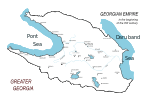Diauehi
| Kingdom of Diaokhi | ||||||||||||
| Kingdom | ||||||||||||
| ||||||||||||
 Map of Diaokhi (12th century BC) | ||||||||||||
| Capital | Zua (12th - 9th century BC) Ultu (9th - 8th century BC) | |||||||||||
| Political structure | Kingdom | |||||||||||
| History | ||||||||||||
| • | Established | 12th century BC | ||||||||||
| • | Disestablished | 8th century BC | ||||||||||
| ||||||||||||
| Today part of | Countries today
| |||||||||||
| Warning: Value not specified for "continent" | ||||||||||||
| History of Georgia |
|---|
 |
|
History by topic |
|
|
Diauehi or Diaokhi, Daiaeni [1] (Georgian: დიაოხი) was a coalition of tribes, or kingdoms, located in northeastern Anatolia, that was formed in the 12th century BC in the post-Hittite period. It is mentioned in the Urartian inscriptions.[2] It is usually (though not always) identified with Daiaeni of the Yonjalu inscription of the Assyria king Tiglath-Pileser I’s third year (1118 BC). Diauehi is a possible locus of proto-Kartvelian; it has been described as an "important tribal formation of possible proto-Georgians" by Ronald Grigor Suny (1994).[3]
Although the exact geographic extent of Diauehi is still unclear, many scholars place it in the Pasinler Plain in today’s northeastern Turkey, while others locate it in the Turkish–Georgian marchlands as it follows the Kura River. Most probably, the core of the Diauehi lands may have extended from the headwaters of the Euphrates into the river valleys of Çoruh to Oltu. The Urartian sources speak of Diauehi’s three key cities – Zua, Utu and Sasilu; Zua is frequently identified with Zivin Kale and Ultu is probably modern Oltu, while Sasilu is sometimes linked to the early medieval Georgian toponym Sasire, near Tortomi (present-day Tortum, Turkey).[4]
This federation was powerful enough to counter the Assyrian forays, although in 1112 BC its king, Sien, was defeated by Tiglath-Pileser I. He was captured and later released on terms of vassalage. In 845 BC, Shalmaneser III finally subdued Diauehi and downgraded its king, Asia, to a client ruler.
King Asia of Diauehi (850–825 BC) was forced to submit to the Assyrian king Shalmaneser III in 845 BC, after the latter had overrun Urartu and made a foray into Diauehi. In the early 8th century, Diauehi became the target of the newly emerged regional power of Urartu. Both Menua (810–785 BC) and Argishti I (785–763 BC) campaigned against the Diauehi king, Utupurshi (c. 810–770 BC), annexing his southernmost possessions and forcing him to pay tribute, which included copper, silver and gold.
Diauehi was finally destroyed by Colchian incursions by about the 760s BC, the date of the last recorded references to Diauehi.
References
- ↑ Henri J. M. Claessen; Peter Skalnik; Walter de Gruyter (Jan 1, 1978). The Early State. Mouton Publishers. p. 259. Retrieved 27 June 2014.
- ↑ A. G. Sagona. Archaeology at the North-East Anatolian Frontier, p. 30.
- ↑ Ronald Grigor Suny (1 January 1994). The Making of the Georgian Nation. Indiana University Press. pp. 6–. ISBN 978-0-253-20915-3. Retrieved 25 August 2013.
- ↑ G. L. Kavtaradze. An Attempt to Interpret Some Anatolian and Caucasian Ethnonyms of the Classical Sources, p. 80f.
Further reading
- Antonio Sagona, Claudia Sagona, Archaeology At The North-east Anatolian Frontier, I: An Historical Geography And A Field Survey of the Bayburt Province (Ancient Near Eastern Studies) (Hardcover), Peeters (January 30, 2005), ISBN 90-429-1390-8
- Georgia. (2006). Encyclopædia Britannica. Retrieved February 14, 2006, from Encyclopædia Britannica Premium Service
- Kavtaradze, G. L., "An Attempt to Interpret Some Anatolian and Caucasian Ethnonyms of the Classical Sources", Sprache und Kultur, # 3 (Staatliche Ilia Tschawtschawadse Universitaet Tbilisi für Sprache und Kultur Institut zur Erforschung des westlichen Denkens). Tbilisi, 2002.
- Melikishvili, G. A., "Diauehi". The Bulletin of Ancient History, vol. 4, 1950. (Publication in Russian)
- (Russian) С. Д. Гоготидзе, Локализация «стран» Даиаэн-Диаоха.

